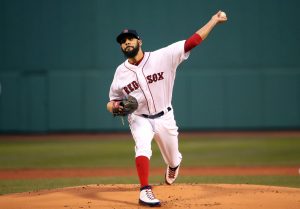Veteran left-hander David Price won’t pitch in 2023, his agent Bo McKinnis told Jon Heyman of the New York Post. Price is a free agent after spending the last season with the Dodgers. A report came out during the season that Price was planning to retire at the conclusion of the 2022 campaign, but the player denied that report. Heyman notes that his agent isn’t using the retirement word here either.
Price, now 37, was drafted first overall by the Rays back in the 2007 draft, quickly making his way through the minors and pitching a handful of innings in 2008. Price would establish himself in the Rays’ rotation the following year, and spent the next five-and-a-half seasons dominating American League lineups with Tampa Bay. He’d wind up throwing 1,143 2/3 innings of 3.18 ERA ball, winning a Cy Young award in 2012, making four All Star appearances and helping the Rays make the playoffs between 2010-12.
As is often the case with smaller market teams, trade speculation swirled as the Rays record dipped below .500 and Price’s club control ran down. The Tigers swooped, landing Price in a 2014 deadline that landed the Rays Willy Adames and Drew Smyly among others. Despite joining a Tigers rotation that featured Max Scherzer and Justin Verlander, the team was swept in the ALDS by Baltimore that year.
The Tigers still controlled Price for one more year in 2015, and he started the year out in their rotation. Yet despite pitching to a 2.53 ERA in 21 starts, the Tigers fell out of contention and with his free agency pending, they flipped him to the Blue Jays for Matthew Boyd, Daniel Norris and Jairo Labourt. Price continued his excellent ways in Toronto, tossing 11 starts of 2.30 ERA ball and helping the Blue Jays through a memorable post-season that finished with defeat to the Royals in the ALCS. All told, it was an outstanding free agency platform year of 220 1/3 innings of 2.45 ERA ball and a runner up finish in AL Cy Young voting.
That winter, Price landed a monster seven-year, $217MM deal with the Red Sox. While he did throw an impressive 230 innings in his first season in Boston, the 3.99 ERA was well shy of his dominant best. After throwing 185+ innings in seven-straight seasons, injuries plagued much of the remainder of Price’s Boston career, and he’d make just eleven starts in 2017. He’d back that up with 30 starts in 2018, pitching to a 3.58 ERA as the Red Sox won the World Series, with Price throwing 13 2/3 innings of 1.98 ERA ball in the Fall Classic. Unfortunately, he’d again find himself battling injuries in 2019 as he tossed 107 1/3 innings of 4.28 ERA ball.
That’d wind up being Price’s last year in Boston, as new chief baseball officer Chaim Bloom packaged up Price and superstar Mookie Betts and sent them to the Dodgers for Alex Verdugo, Jeter Downs and Connor Wong. That trade took place not long before the pandemic forced the shut down, and eventually shortening of the 2020 season. Price would opt out of that season, instead returning in 2021 as a bullpen option for LA. He was reasonably effective in that role, pitching to a 4.03 ERA in 73 2/3 innings, but he did post a career-low strikeout rate of 17.8% and saw his velocity drop.
He rebounded in 2022, remaining in a relief role and pitching 40 1/3 innings of 2.45 ERA ball, posting vastly improved strikeout and walk rates, both of which had been trending in the wrong direction a year earlier. While it’s not necessarily the end of the road for Price, he currently boasts an impressive career record of 157-82 over 2,143 2/3 innings (322 games started out of 400 appearances) with 2,076 career strikeouts. He’s also a five-time All Star, has one World Series ring with the Red Sox in 2018 and an AL Cy Young award (as well as two runner up finishes).

 Although still without much playoff success, Price spun his great career and commanding contract-year performance into a massive seven-year, $217MM contract with the Boston Red Sox and bolding stating that he “
Although still without much playoff success, Price spun his great career and commanding contract-year performance into a massive seven-year, $217MM contract with the Boston Red Sox and bolding stating that he “